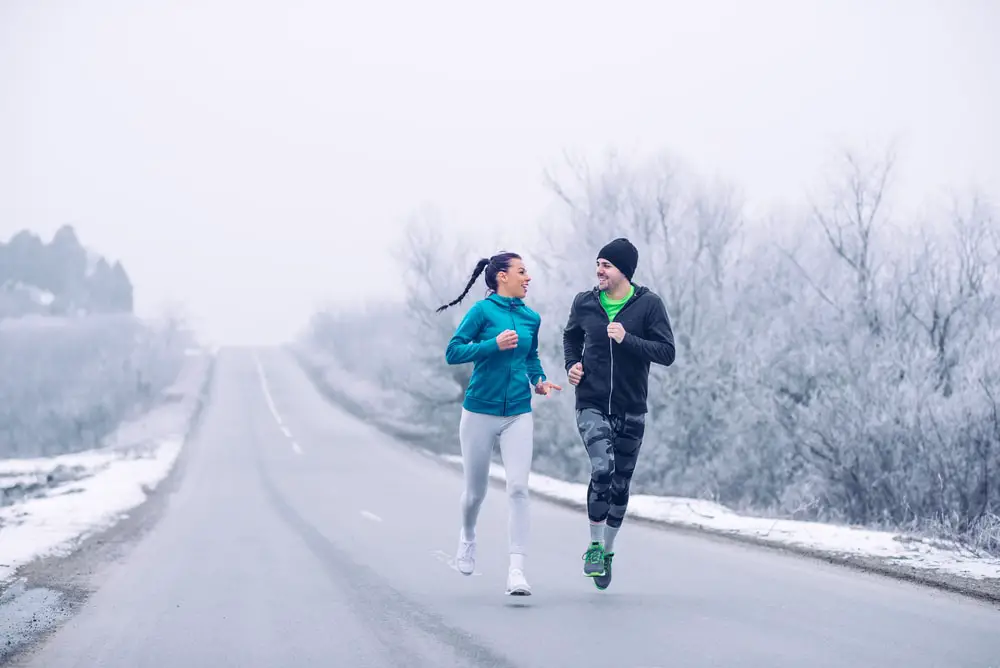If you genuinely enjoy running, you probably don’t want to stop doing it in the winter, especially if you live somewhere where the winters can last anywhere from three to six months. Luckily, cold weather doesn’t always mean it’s time to transition to the treadmill.
Running in the winter can be challenging, but it’s easier if you have the right cold weather running gear to keep you warm and comfortable throughout your run. You’ve come to the right place if you don’t know what that gear is.
This article explains what winter running clothes you need to stay warm during your runs and enjoy them just as much as you do in the summer.
Winter Running Clothes: What Do You Need?
The right winter gear is key to enjoying your runs in cold weather. Although warmth is the priority for winter running clothes, you also want to consider comfort and the overall look of the clothes you choose.
The three essential items you need for your winter runs are:
- Jacket
- Gloves
- Shoes
Let’s take a closer look at what you should look for in these three items.
Winter Running Jacket
A winter running jacket is essential for winter conditions because keeping your core warm should be a top priority when running in the cold.
A few key things that you should be sure to factor into the winter running jacket you choose are:
- Material
- Comfort
- Fit
- Warmth
The material of your winter running jacket is the most critical element to consider, as the material also influences comfort, fit, and warmth. However, your outer layer doesn’t need to be filled with down to achieve maximum warmth. Also, since you are using this jacket for running, there is such a thing as being too warm, and you want to avoid overheating during cold weather runs.
For example, a jacket with fleece lining may do the trick to keep you warm enough in cold temperatures. Better yet, choose a coat with ventilation or sweat-wicking technology to handle moisture, prevent you from getting too warm, and ensure your comfort during your cold weather run.
Moreover, you want your jacket to fit closely to your body. This outer layer shouldn’t be too snug to the point that it’s uncomfortable, but you also don’t want it to be too loose, as that allows air to enter the jacket. You should also choose a coat with cuffs on the sleeves to prevent cold air from getting in there as well.
Finally, you should also consider any additional features you’d want in your jacket that would benefit your run, including thumbholes or an abundance of pockets to store your stuff.
Winter Running Gloves
Choosing winter running gloves requires similar criteria to selecting a winter running jacket, including material, warmth, and comfort. Beyond these three elements, however, you should consider features unique to gloves, specifically touchscreen fingertips.
Touchscreen fingertips are a must for most people who wear gloves, but they are even more important for winter running gloves. Think about how inconvenient it is to remove your gloves whenever you need to do something simple on your phone, such as changing a song or answering a call. The warmth escapes your glove, making you feel cold again.
Touchscreen fingertips eliminate the need to remove your gloves during your run. The touchscreen technology is usually found on the index finger and the thumb of the glove, but you may also sometimes find gloves that have it on additional fingers — if not all fingers — for added versatility.
Moreover, many winter running gloves also have a non-slip grip on the palm to ensure your safety throughout your run.
Winter Running Shoes
Running shoes are an important piece of running gear for any run, but if your winters sometimes feature an abundance of snow or ice, having the right running shoes is even more important.
In the winter, you may face a variety of obstacles during your runs, including:
- Slushy sidewalks
- Black ice
- Snow and mud
These obstacles make your run harder and may also make it dangerous. Your winter running shoes should have weatherproof features for maximum safety and agility.
One feature that is key for winter running shoes is waterproof material. You should choose a running shoe with a waterproof membrane to prevent wet socks, which could lead to frozen toes. You may also want shoes with a higher cut to protect your ankles.
You’ll also want to look for shoes with reliable soles and lugs for grip, like a trail running shoe. Even if you pay close attention to the road during your run, you might not always see when ice is ahead. When your shoes have enough grip, you stand more of a chance against black ice.
Finally, you should also consider any additional features you’d want in your jacket that would benefit your run, including thumbholes or an abundance of pockets to store your stuff. A reflective vest or other reflective gear, in addition to your jacket, may also be necessary if you take winter runs in the dark.
Wrap-Up: Winter Running Clothes Extend the Running Season
Winter running clothes ensure that you stay warm and comfortable throughout your run.
This gear doesn’t have to look too different from your regular running clothes, and you don’t have to break the bank to get warm, comfortable clothing. That said, ensure that you get winter running gear suitable for the type of winters you experience in your area. After all, winters in California look much different than in Minnesota. If you live in a colder climate, you may also have to think about adding a base layer, including running tights and long sleeve shirts.
So if you’re training for a marathon or simply want to keep up with your routine, invest in winter running clothes to ensure that you run your best.


